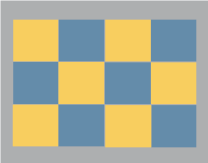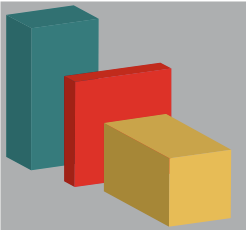The Munsell text states: ‘there seems to be a universal perception that some hues seem warm while others seem cool. It is a perceived red or yellow content that makes a hue seem warm and a blue content that makes a hue seem cool.” When referring to the color wheel, notice that it can be divided into two distinct temperature ranges: warm and cool. The colors yellow, yellow-orange, orange, red-orange, red and red-violet appear as our warm colors. The colors yellow-green, green, blue-green, blue, blue-violet and violet are relatively cooler.
3/13/09
Read Chapter 5: Color Anomalies, Preference, and Emotional Response in the Munsell text for further discussion.
3/13/09
Sketchbook Exercise: Explore a minimum of 6 colors ( 3 sets of transitions, 1" x 8" grids) in your sketchbook by mixing a range of the same hue creating a warm to cool transition. Example- consider a warm yellow (leaning towards a yellow –orange) and create a full gamut of color ranging to a cooler, green-yellow. Shifts can be subtle but smooth, creating a fluid transition. Do this with a number of colors until you feel comfortable with a choice for the next composition.




Student Sample
Warm to Cool Transition
3/13/09
Assignment #6 Color Temperature
Directions:
Materials:
12" x 12"Illustration Board, Ruler, Triangle, Compass, Protractor, Hard Pencil (2H, 4H), Removable Tape, Xacto knife, Goldens Acrylic Paints, Brushes…
References- Temperature transition scales
You will be creating a 5x5 grid consisting of 2” squares on a 12” square illustration board with a 1” border along the parameter. Design a motif (repeated pattern) of shapes that will serve as a vehicle for a gradation change of a color from warm to cool.
Gradation: The transition of your color temperature change should occur diagonally (from one corner to another) in nine steps. Diagonal pattern of color transition is similar to that of your Chroma/Saturation design.
Example:

The accurate display of your ability to change the temperature of a color painted in a clean, flat manner is important.

Student Sample
Advancing and Receding Colors:
It is important to note that the warm colors generally appear to pull forward in space and cool colors appear to recede. Warm colors are often times used to describe light while cool colors are used to describe shadow or lack of light. The spatial effect color temperature produces in a composition can be utilized if mixed and placed in proper context.
3/13/09
Sketchbook Exercise:
1. From Munsell, page 54: Try the following on the computer (use a drawing program such as Illustrator). Create a checkerboard pattern of warm and cool colored squares. Open a blank screen and change the background color from white to middle gray. Draw 12 squares of similar size, about 1” x 1” each. Drag the squares and arrange them in a checkerboard pattern. Select half of the squares, every other in the pattern (multiple selection of items is usually possibly by depressing and holding the shift key while selecting.) Fill these squares with a warm, light, vivid color such as bright yellow. Select the other 6 squares and fill them with a cool, dark, dull color such as dark blue-gray. Then select all 12 squares and change the black lines defining the squares to “no line.” View the colored checkerboard pattern from a distance. Which squares seem closer in distance, the warm, light, vivid color or the cool, dark dull color? Print it out and place it in your sketchbooks.

2. Use a page in your sketchbooks to create a composition of shapes using one-point perspective. Demonstrate the effect of accurate color on depth perception with paint. Example: If you were to draw a cube, the face would receive the most amount of light and be the strongest color. The top would be a slightly darker, grayer version of that color. The side that receives the least amount of light would be the darkest and most gray version of that color. Overlap shapes to further the appearance of objects advancing and receding in your composition. Keep in mind the warm colors tend to advance and cool recede.

No comments:
Post a Comment